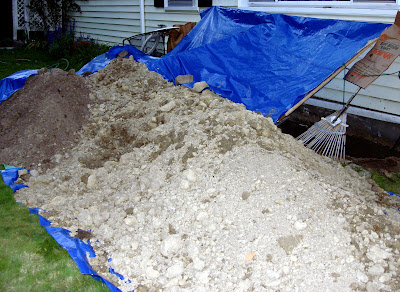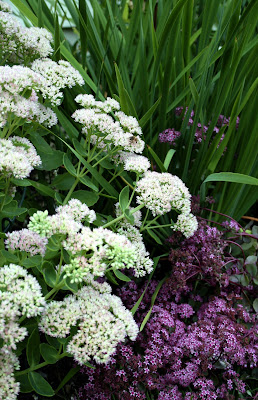
Daffodil "Mount Hood," 2007
When it's late September and part of your garden looks like this . . .

Yes, the foundation wall work continues. The yawning pit should be back-filled within a week. No time to return perennials to their rightful homes, but time enough to plant spring bulbs. Here's this year's order (and suppliers).
Along the back of the house, where foundation work is currently underway:
100 Grape hyacinths/purple (Tulips.com) to fill gaps in the border
100 Tulip dasystemon/yellow and white (John Scheepers), again for the border
100 Tulip "Apricot Impression"/orange (John Scheepers)
20 Tulip "Black Parrot"/deep purple (Holland Bulb Farms), just for fun
Corner of the new side bed:
30 Daffodil "Hawera"/yellow (Tulips.com), a miniature, multi-flowered variety
Corner of the old back bed:
20 Tulip "Princess Irene"/deep red, orange, and purple (Tulips.com)
10 Allium "Firmament"/purple (John Scheepers)
Front yard, to replenish existing supplies:
100 Iris danfordiae/yellow (John Scheepers)
100 Allium osttrowskianum/fuschia (John Scheepers)
Two concerns I've been wrestling with:
1. How to discourage squirrels from uprooting the tulip bulbs? Alliums and grape hyacinths are said to act as deterrents, so I'll slip them in nearby. Oh, yes, and I'm planning to lay chicken wire over the tulips along the back of the house.
2. How to time transplanting displaced perennials and putting in new dahlias? Except for the species tulips, I treat the other tulip varieties as annuals. No apologies, that's how I was raised. So when the "Princess Irene" tulips are spent, dahlias will go in; and when the "Apricot Impression" and "Black Parrot" tulips are pulled out, the perennials will be transplanted from their over-wintered holding bed.
One concern that I've largely dodged, being fearful that my head will explode if I factor any more variables, is how these blooms will all look together. I'll accept any serendipitous pleasures.





















